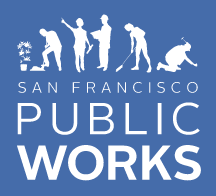Street Resurfacing Program
Overview
NOTE FOR MAP ABOVE: All Public Works Street Resurfacing Program candidates are subject to substitution and schedule changes pending available funding, visual confirmation, utility clearances and coordination with other agencies and are NOT guaranteed to be moved forward to construction. Unforeseen challenges, such as increased work scope, changing priorities, cost increases or declining revenue may arise, causing the Public Works Street Resurfacing Program candidates to be postponed or dropped from consideration.
Street Resurfacing Treatments
Pavement Preservation - Surface sealing is a resurfacing technique that is applied to the existing street surface. Surface sealing preserves the asphalt pavement by protecting the surface from the effects of natural aging and the environment. Surface sealing can extend the life of pavement at a fraction of the cost versus other resurfacing techniques by rejuvenating the wearing surface of a street and sealing the surface off to moisture. More information on the Pavement Preservation Program.
Grinding and Paving - Grinding and paving is a street resurfacing technique used on streets which have deteriorated past the point of micro-surfacing or other pavement preservation techniques The grinding and paving technique is typically performed by first removing (grinding) off two inches of the existing asphalt “black top” surface and then replacing it with two inches of new asphalt along the whole street segment.
Full Street Reconstruction - Full street construction is when a street segment will be fully replaced. Reconstruction of the street involves a complete removal and replacement of the existing pavement surface and the concrete street base followed by installation of new concrete base and street surface.
Report a Pothole
San Francisco Public Works strives to provide World Class Service. Reporting a pothole is easy. Visit the 311 website.
Frequently Asked Questions
How Does Public Works Determine Which Streets To Schedule For Resurfacing Work?
The Public Works Street Resurfacing Program uses the following factors when considering projects for resurfacing:
Why Are Some Streets Receiving Street Maintenance, But Appear To Be In Really Good Condition?
Proper maintenance is what makes your car, house and street last long. If a street is resurfaced while still in relatively good condition, the street will continue to function properly for many years. It is important to protect the City’s investment in the street system and maintain streets before they deteriorate beyond simple repair. Streets requiring full reconstruction are extremely expensive.
How Will Public Works Let Citizens Know What Is Going On With Street Repairs?
Public Works acknowledges street resurfacing projects can affect your neighborhood and commute. If a street resurfacing project is occurring on your street, construction crews will place "no-parking" signs on the affected block at least 72-hours in advance of work. The "no parking" signs will alert motorists of the street closure and will indicate the specific date(s) and times the work will occur.


